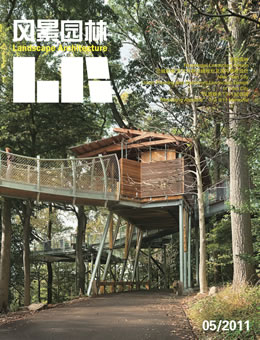撰文 (美国)乔-布莱恩-布雷
Text by Jon Bryan BURLEY (US)
翻译 熊瑶
Translation by XIONG Yao
风景园林学在世界上许多地区都是一项非常城市化的活动,并且身处城市环境中的设计师们习惯于去创造广场、交通走廊、商业区以及住宅类项目。然而,在其他地区,比如北美,许多景观都包含了荒野环境和自然区域。100年前,老奥姆斯特德开始从事有关建立国家公园、森林管理、乡村土地管理以及国土保护等自然土地的管理活动。在人口稠密的城市地区生活的人们都会惊讶北美会出现如此多的开放和无人居住的地区。在那里,空气和水都比较干净,还栖息着许多自然种群如鸟类、两栖类、爬行类、鱼类和哺乳动物。因此,在北美的从业人员拥有既能在人口密集的城市地区又能在人烟稀少的地区进行规划和设计的技能。穆尼博士便充分体现了这样的专业知识和能力。他对鸟类栖息地的研究说明了风景园林师如何能综合博物学知识并构建一系列有关利用含有多个野生动物种群的景观的调研活动。穆尼博士的学术著作的主要部分代表着许多西方学者的期望,即研究者必须不断地获取新的知识并开拓新的研究。一个西方学者不会停留在一两个主要成果之上,并在未来30年中不断重复此前的成果。西方学者往往会在过去的调查研究基础上,不断开发新的研究。因此西方学者开始采用一种利用过去的知识储备辅助将来深度研究的方法,从而建立另一项新研究。而穆尼博士在为将来研究建立知识库方面就一直非常成功。
不断追求新信息,这一要求深植于西方大学和大学对其教职人员的管理,其中一个驱动力和控制力就是要在同行评审期刊上发表论文。同行评审过程是一项双盲评审过程,即研究者不知道是谁的评论并且评论者也不知道研究者是谁。审查的主要目标是确定在文章中是否有新的知识,而研究员的主要目标是提出新的知识。在西方,风景园林学科的研究人员通常需要每年发表一到三篇此类论文。由于作者是匿名的,因此其以往的知名度和地位不会影响到论文评审意见;甚至成名的学者,如果他没有一些新的报告,那么杂志将不会发表他们的文章。因此,在西方,持续的压力一直敦促着学者们不断发展新思路和新研究,即使在其职业生涯已步入功成名就之时也依然如此。每年这些学者必须以生产新的知识来证明自己的研究能力。穆尼博士正是这样一位有能力不断开拓新思路和新成果的学者。
穆尼博士的这篇论文说明了这一创造性的研究过程。此外,他在众多的学术范畴里都颇有成果,如历史建筑保护、促进人类健康的设计、景观生态学研究。具有这种多样化的能力是大多数风景园林师的典型代表。即使是在奥姆斯特德的时代,风景园林师也通常具有这种能力。奥姆斯特德不仅设计了城市公园,还设计了大学校园、世界博览会、安居工程、大型庄园,并且还入手管理广泛的自然区域。在西方,大多数风景园林师都经过培训以从事大量规划和设计的实践,所以学者便可以在众多的规划和设计课题中从事研究也不足为奇。这也是许多中国开设风景园林的高校治学的方向。
中国东部沿海地区人口稠密并发展迅速,但中国西部的大部分地区很像北美洲和南美洲以及澳大利亚的广阔区域,宏观的规划设计中景观生态学应用前景广阔。让许多西方人惊讶的是,在他们想象中人口稠密且仅有少量自然区域的中国,竟有如此多独特和美丽的自然区域遍及整个中国东部,从温带森林和哈尔滨以北的火山景观到南至越南边境的沿海岛屿和河口地区。中国内地的地质、生物、植物、文化资源都十分丰富。为了开发潜在的旅游资源,这些特殊的地方可能有时会被忽视。但风景园林师通过深思熟虑的规划、设计和管理可以保护这些自然区域,并丰富这些属于中国的美丽的自然资源。这些自然地区对于研究者而言具有巨大的机遇。穆尼博士的研究表明,一个加拿大的风景园林学教授如何在他的国家处理自然资源的问题。在中国,许多一流的风景园林院校也在为本土做着同样的研究。
Landscape architecture in some parts of the world is a very urban activity and designers from these urban locations are accustomed to creating plazas, transportation corridors, commercial districts, and housing projects. However, in other parts of the world such as in North America, much of the landscape is comprised of wilderness and natural areas. Over 100 years ago, Frederick Law Olmsted Sr. was engaged in such naturalistic land management activities related to the creation of national parks, forestry management, agricultural land management, and land preservation. People from dense urban areas are surprised how open and unpopulated much of North America appears. The air and water are relatively clean, with many natural populations of birds, amphibians, reptiles, fish, and mammals inhabiting the environment. Thus landscape architects who practice in North America have skills to plan and design in both dense urban areas and in less populated areas. Dr. Patrick Mooney exemplifies such expertise and abilities. His research concerning avian habitat illustrates how the landscape architect is able to synthesize natural history knowledge and construct inquiries concerning the use of the landscape by multiple wildlife species. Dr. Mooney’s body of scholarly work typifies the expected demands of the Western scholar where the investigator must continually build new knowledge and forge ahead with new studies. A Western investigator cannot rest upon the strength on one of two major findings and then repeatedly report such findings over the next 30 years in repeatedly similar papers. The Western scholar must continually develop new studies that often build upon past investigations. Thus the Western scholar embarks upon an approach where the past knowledge contributes to the next study, leading to another study. Dr. Mooney has been extremely successful at constructing a knowledge base from which the next study emerges.
One of the driving and controlling forces associated with this continual quest for new information imbedded in the demand by Western universities and university administration for their faculty to publish in peer reviewed journals. The peer review process is a double blind peer review process, were the research does not know who the reviewers are and the reviewers do not know who the researcher is. The major goal of the reviews are to determine if there is new knowledge in the article and the major goal of the researcher is to present new knowledge. Normally in the West, a researcher in landscape architecture must successfully publish one to three such papers a year. Since the identity of the researcher is hidden, the past fame and importance of the researcher does not affect the opinions of the reviewers. For even a famous or important landscape architectural researcher, if he or she does not have something new to report, they will not be published in a journal ever again. Therefore in the West there is continual pressure for the researcher to develop new ideas and studies even during the senior portion of their career. The Western researcher must be able to prove oneself capable of producing new knowledge each and every year. Dr. Patrick Mooney is someone who has been able to continually reveal new ideas and results.
The paper presented by Dr. Mooney illustrates this creative research process. In addition, Patrick is very capable in numerous scholarly areas such as historic preservation, human health design, as well as landscape ecological studies. This diverse ability is typical of most landscape architects. Even during Olmsted’s era, landscape architects often had a diverse set of abilities. Olmsted not only designed urban parks but also designed university campuses, world expositions, housing projects, large estates, and managed extensive natural areas. In the West, most landscape architects are trained to address this broad array of planning and design projects and so it is not surprising that the landscape architectural researcher can also address research across numerous planning and design topics. This is also true for many of the great landscape architectural schools in China.
While much of China is densely populated and developed, much of Western China is like the vast expanses of North and South America as well as Australia, where landscape ecological studies in planning and design are pertinent and useful. To the surprise of some Westerners who imagine Eastern China as being densely populated with little natural areas, there are many unique and beautiful natural areas throughout the east of China from temperate forests and volcanic landscapes north of Harbin, to the islands and estuaries along the ocean and south to the border of Vietnam. Inland China is very rich in geological, biological, botanical, cultural resources. Expect for their tourism potential, these special places can be sometimes overlooked, but thoughtful planning, design, and management by landscape architects can protect these natural areas and enrich the beautiful natural resource heritage that belongs to China. These natural areas possess great opportunities for investigators. Dr. Mooney’s research illustrates how a landscape architectural professor in Canada addresses natural resource research in his country. Some of the best landscape architectural schools in China are doing the same for China.
作者简介:
乔-布莱恩-布雷/博士/美国密歇根州立大学规划设计建设学院风景园林系教授/美国风景园林师协会资深会员
Biography:
Dr. Jon Bryan BURLEY is a professor of Landscape Architecture at the School of Planning Design and Construction, College of Social Science and College of Agriculture and Natural Resources, Michigan State University. He is also a Fellow of American Society of Landscape Architects.
译者简介:
熊瑶/1983年生/女/博士/南京林业大学艺术设计学院讲师(南京 210042)
About the Translator:
XIONG Yao, who was born in 1983 and holds a doctorate degree, is a lecturer at the School of Art Design, Nanjing Forestry University. (Nanjing 210042)
 《风景园林》2011第5期导读
《风景园林》2011第5期导读
Leave a Reply